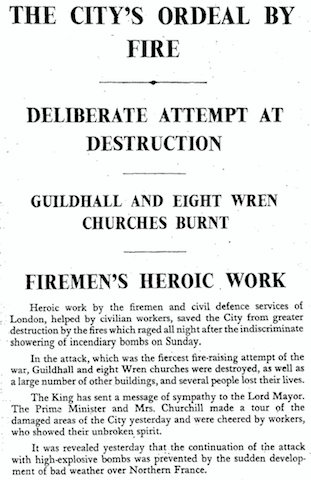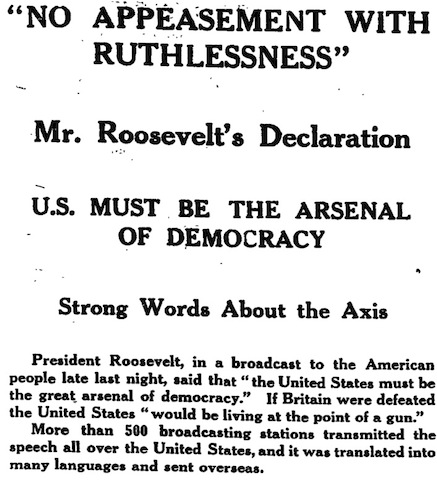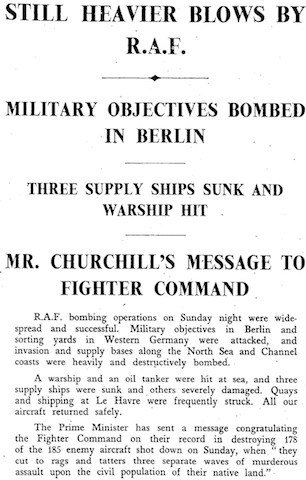
The true extent of the destruction caused by Sunday night’s air raid on London has now become clear (the story has now moved to first place on page 4 of The Times, though in the Guardian the ‘Second Great Fire of London‘ shares that honour with news of RAF raids on Germany and Italy). The human cost is actually surprisingly low (more on that later) but severe, irreparable damage has been done to many of the City’s historic buildings. The Times‘s leading article sums it up (5), making no attempt at dispassion:
From the military point of view the damage caused was negligible. But if the enemy’s purpose was the destruction or damage of historic buildings, he may well claim a substantial addition to his record of senseless destruction of the noblest works of man. Guildhall has been severely damaged, and thus a modern tyrant has had his passing revenge on the source and home of resistance to despotism and lawlessness in the past. The Central Criminal Court was another very suitable target for HITLER’s airmen. St. Bride’s with its spire, which HENLEY called a “madrigal in stone,” is a charred shell, and St. Lawrence Jewry, the LORD MAYOR’s official church, is also burned out. Five other churches are seriously damaged. St. Paul’s itself was saved by heroic efforts, but WREN’s Chapter House — a lovely building — was gutted. Many lesser-known buildings are scarred by the flames; but the destruction of so many of WREN’s churches, all signal expressions of a great age of English thought and feeling, is irreparable.
Apparently the second phase of the attack, when the incendiaries would have been followed by high explosive bombs to block roads, destroy buildings and rupture gas and water mains, was prevented only by the onset of bad weather in northern France. This would have made the firemen’s job much harder. So The Times‘s aeronautical correspondent is joining the call for more firewatchers on the roofs of private buildings, to put out incendiaries as quickly as possible (2).
The main story focuses on the lost buildings, which are worth dying for (4):
London carried on with admirable calm and fortitude. Firemen, wardens, and other civil defence workers held on grimly, and many died that London might be saved.
Of course, not many people actually live in the City. But other parts of London were hit too. There are several stories such as the following (2):
A demolition squad were engaged yesterday in clearing away débris under which a man and his wife and their nephew were buried. The nephew was to have been married in a fortnight’s time.
One disaster happily averted was the threat of fire to ‘London’s greatest shelter, in which there were about 1,500 people’. In fact there were more than that, as ‘Some thousands of people’ came to it from other shelters also under threat. It was surrounded by flames at one point, and the building above was hit by ‘a shower of incendiary bombs’. It was nearly decided to evacuate, but luckily it didn’t come to that.
The aeronautical correspondent of the Manchester Guardian claims that (5):
The raid was marked by plain evidence that we are now building up our defence system in the [unclear] against these night attacks, for RAF night fighters were heard above the city, and it was clear that they were engaging enemy bombers.
This is something which had been announced some months ago, and ‘It cannot be denied that certain statements raised premature hopes amongst the public’ that a defence against the night raider would soon be found. (On the same page, Air Chief Marshal Dowding, now in Ottawa, makes another such statement.) But it’s a difficult problem, there is much happening behind the scenes, and ‘what system has been formulated to counter night raids cannot be divulged’.
In Manchester, two men have been sentenced and another charged for separate post-raid looting incidents. A soldier named Alexander Lang received three months for stealing from a market stall ‘cash, postage stamps, a padlock, a propelling pencil, a fountain-pen, and other articles to the total value of 15s.’ (10). Patrick Peterson, a labourer, stole ‘an enamel kettle and a brass jug from a house which had been wrecked by enemy action and which the tenant’s wife was killed’. He got four months. The third man, ‘said to be an A.F.S. man’, is charged with ‘stealing articles to the value of seven shillings’.
Finally, from page 5:
BERLIN, DECEMBER 30.
A team of a German Guard regiment challenged a group of British prisoners in an Eastern German camp to a game of football. When the score was 27-0 — in the prisoners’ favour — the game was stopped.
Then the Germans learned that the prisoners were the second team of Aston Villa, who enlisted as a body and were captured at Dunkirk. — Associated Press.
![]() This work is licensed under a Creative Commons Attribution-NonCommercial-NoDerivatives 4.0 International License.
Permissions beyond the scope of this license may be available at http://airminded.org/copyright/.
This work is licensed under a Creative Commons Attribution-NonCommercial-NoDerivatives 4.0 International License.
Permissions beyond the scope of this license may be available at http://airminded.org/copyright/.






Pingback: Airminded · Wednesday, 1 January 1941
Pingback: Airminded · Friday, 3 January 1941
Pingback: Airminded · Thursday, 30 April 1942